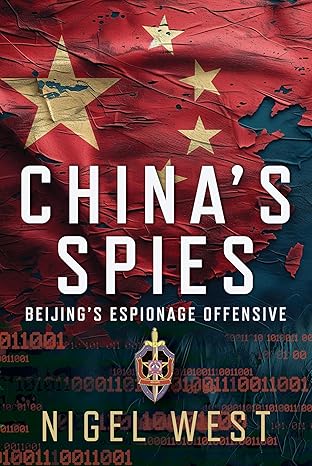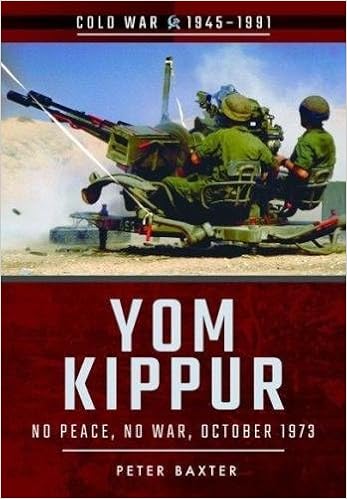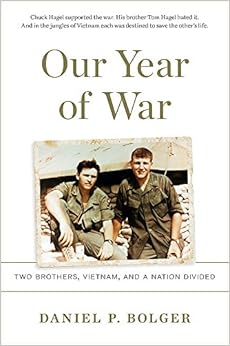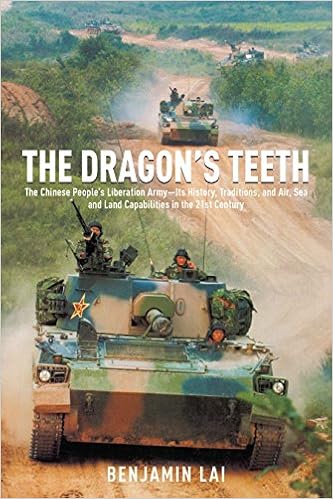The Borinqueneers: 65th Infantry Regiment
By Daniel Ramos
Brief History
During his second voyage to the New World, Christopher Columbus arrived on the Caribbean island of Puerto Rico on November 19, 1493. The island was inhabited by an indigenous people known as the Tainos, who had migrated from South America to the Caribbean. At the time the Island had no official name. The Tainos referred to their home island as Boriken or Borinquen, which means “Land of the Valiant Lords.” Over the years, many traders and sailors began calling the island Puerto Rico (Rich Port). Spanish Conquistador Juan Ponce De Leon served as lieutenant to Columbus during his second voyage. In 1508, Ponce De Leon established the first Spanish settlement on the island and became the first governor of Puerto Rico. Almost 400 years later, Spanish control of Puerto Rico ended in 1898 after Spain’s defeat in the Spanish-American War. Spain ceded control of the Philippines, Guam, Cuba, and Puerto Rico to the United States. On December 10, 1898, Puerto Rico officially became a US territory.
Origin of the 65th Infantry Regiment
By an act of congress on March 2, 1899, the first Puerto Rican unit was formed for US military service. It was a volunteer battalion comprised of four companies with 100 men each. By February 1900, the unit had grown to regiment size. A second act of Congress made the Puerto Rican regiment part of the US Army on May 27, 1908.
During World War I, the regiment was never deployed overseas, but ironically was the first unit of the United States Army to engage forces of the German Empire. On March 21, 1915, a German supply ship trying to force its way out of San Juan Harbor to deliver supplies to German U-boats in the Atlantic came under fire from positions at El Morro Castle manned by the Puerto Rican regiment. The Germans were forced to surrender the ship and its supplies. In March, 1919, the regiment was officially renamed the 65th Infantry Regiment.
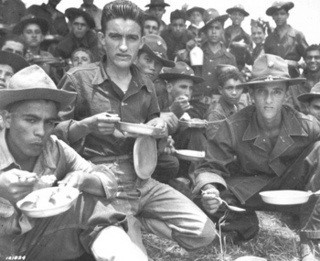
After an all-day training maneuver in Salinas, Puerto Rico; August 1941 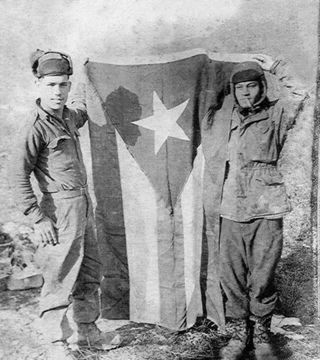
Men of the 65th Infantry Regiment during the Korean War. On the right is Emiliano Figueroa from Santurce, PR. |
On November 25, 1943, the 65th Infantry Regiment, which had been under the command of American officers, was placed under the leadership of Colonel Antulio Segarra, making him the first Puerto Rican army officer to command a regular US Army regiment. The 65th would see combat in Italy, France, and Germany during World War II. A total of 65,034 Puerto Ricans served in the US military during World War II. However, the battles against the Nazis in Europe would be overshadowed within a few years by the epic battles against communism in Korea during the Cold War.
The 65th Infantry Regiment in the Korean War
On June 25, 1950, communist North Korea had invaded South Korea, threatening to bring all of Korea under communist rule. The United States and its allies had been growing increasingly concerned about the spread of communism around the world and the rising influence of the Soviet Union. Before the outbreak of conflict in Korea, Soviet-backed communists had risen to power through Eastern Europe and China. Supplied by the Soviet Union and China, the North Korean army had shattered South Korea’s underequipped forces and was threatening to overrun the country.
Two days after the North Korean invasion of South Korea, President Harry S. Truman ordered American air and naval forces to intervene in Korea, and soon US military commanders would recommend the deployment of American ground troops. In New York City, the United Nations had unanimously passed a resolution authorizing military action to repulse the North Koreans. Besides the United States, 15 UN member nations would deploy combat troops to aid South Korea.
The United States began a rapid mobilization of its armed forces. One of the units deployed was the 65th Infantry Regiment from Puerto Rico. At the time, the regiment was undermanned, comprised of only 92 officers and 1,895 enlisted personnel out of its authorized strength of 4,000. More than half of the regiment’s officers were American, while the enlisted men were entirely Puerto Rican.
The regiment was commanded by Colonel William W. Harris, a West Point graduate and World War II veteran. Before the regiment deployed, Colonel Harris and Brigadier General Edwin L. Sibert arranged for the creation of a personnel replacement center at Camp Tortuguero, Puerto Rico. During the Korean War, Camp Tortuguero trained 30,500 replacements for military service, most of whom would serve with the 65th Infantry Regiment.
Just days before deploying, the regiment bulked up by adding 1,200 reservists and 600 recruits. “If I’d had more time,” Colonel Harris stated, “I could have recruited 50,000.”[1] On August 27, 1950, the Regiment shipped out for Korea. Many of the soldiers in the 65th were World War II veterans, and most were fluent in English and Spanish.
During the long voyage, the men came up with the regiment’s now famous nickname, “The Borinqueneers.” The first part of the nickname refers to Puerto Rico’s original name, given by the Taino natives, who called the island Borinquen. Today, many who were born in Puerto Rico refer to themselves as Boricuas. The second part of the nickname refers to 17th century Caribbean pirates called Buccaneers. The nickname seemed fitting during the voyage across the Pacific Ocean. On September 23, 1950, The Borinqueneers arrived in Pusan, South Korea, which had become the staging base for American and United Nations troops arriving in Korea.
Before the arrival of the Borinqueneers, the previous three months had seen intense combat on the Korean peninsula. The South Korean capital, Seoul, had fallen under North Korean control on June 28, just three days after the invasion began. Outnumbered, and outgunned, the South Korean army was in retreat, causing mass panic amongst the civilian population, which began to flee south with the Army.
The nearest force to assist was the US 24th Infantry Division on occupation duty in Japan. However US Army units in Japan were inexperienced, poorly trained, and poorly equipped since the end of World War II five years earlier. The 24th Infantry was rushed into Korea with disastrous results. On July 6, American troops fought the North Koreans for the first time in the Battle of Osan, just south of Seoul; 540 American troops were soundly defeated by 5,000 North Korean troops. Throughout July, American troops suffered similar defeats at Pyongtaek, Chonan, Chochiwon, and Taejon.
Despite terrible losses, American and South Korean troops succeeded in delaying and slowing down the North Korean advance. By August, American and South Korean troops, pushed to the brink of defeat, had formed a defensive perimeter around the port city of Pusan in a desperate last stand. Backed by overwhelming air and naval power, American, South Korean, and UN troops fought off numerous North Korean offensives to break through the Pusan perimeter. As the North Korean army became increasingly exhausted, reinforcements were arriving into Pusan from the United States and other UN nations. By September, the tide had turned in favor of the UN Coalition.
On September 15, an American-led force had conducted an amphibious landing on the port city of Inchon, just west of Seoul. By the time the Borinqueneers had arrived at Pusan, UN forces had broken the North Korean siege around the Pusan perimeter, and US Marines from Inchon were advancing through Seoul. For the Borinqueneers, spirits were high, and the mood was optimistic. By the end of September, all of South Korea had been liberated.

First Lieutenant Baldomero Lopez, United States Marine Corps, scales the sea wall at Red Beach during the Inchon Landing, September 15, 1950. Minutes after this photo was taken, Lopez sacrificed his life by throwing his body over a live grenade to save his own men. He earned the Medal of Honor posthumously. |
On October 7, UN command authorized its forces to cross the 38th Parallel, the border between North and South Korea, in an attempt to secure total victory. Decimated from severe losses, and facing a reinvigorated multinational coalition, the North Korean army was steadily pushed back.
Assigned to the US 3rd Infantry Division, the 65th Infantry Regiment would primarily be involved in anti-guerrilla activities and cutting off enemy escape routes. The regiment fought its first significant engagement on October 17, when 500 North Koreans attacked E Company at Kumpchon. The battle ended with 79 enemy casualties and 85 captured; 11 Borinqueneers were killed. By the end of October, the 65th Infantry Regiment had inflicted 1,500 casualties on the enemy, at the cost of 221 Borinqueneers killed or wounded. Five silver stars were awarded to men in the unit for gallantry.
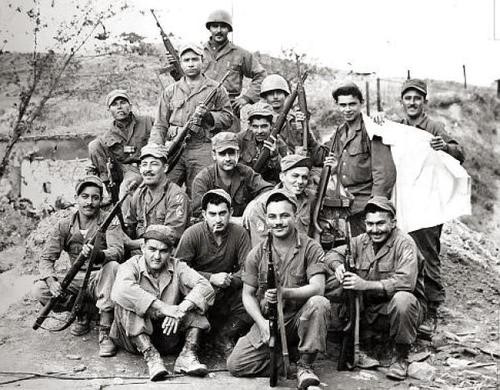
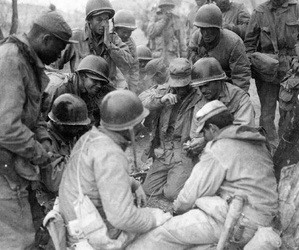
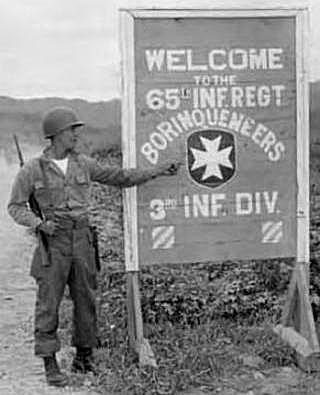
|
As the 65th Infantry Regiment advanced towards the Chinese border, many could see the end in sight. By November, UN forces were advancing towards the Yalu River, and word amongst the troops was that the war could be over by Thanksgiving. Just across the Yalu River, Chinese forces were beginning to mobilize.
Before the war, the communist regime in Beijing had contingency plans to intervene in the event North Korea required assistance. The UN Coalition had ignored numerous warnings from communist China not to cross the 38th Parallel, but a month later, the American-led UN force was approaching the Chinese border and on the verge of total victory.
On November 17, the Chinese army began crossing the Yalu River into Korea under total secrecy. In late November, the weather was quickly deteriorating, and temperatures were rapidly dropping with the onset of winter. At the time, the Borinqueneers were in the area of the Chosin Reservoir, where temperatures had dropped to -35 F. The snow and intense cold was a terrible change from the warm tropical climate of Puerto Rico. To make matters worse, the men lacked winter clothing to protect them from the harsh conditions. UN commanders didn’t expect prolonged fighting into the winter season. Using their own ingenuity, the Borinqueneers found ways of surviving the cold by using all kinds of heat generating equipment, from a blow torch to full- sized tent stoves.
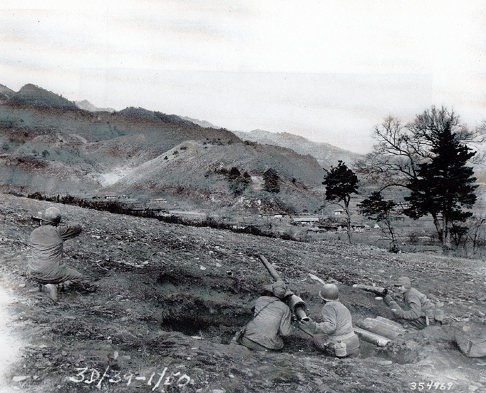
A 75mm recoiless rifle team fires in action against communist forces near Kwangch-on, North Korea; November 25, 1950. US Army Photo 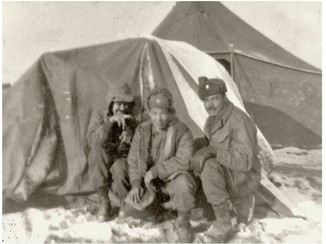
|
Just when it seemed that it couldn’t get any worse, on November 27, all along the front, units were coming under attack and being overrun by tens of thousands of Chinese troops. As it turned out, units of the Chinese People’s Volunteer Army had entered Korea on October 19, and despite reports over the past month from UN troops that they had engaged and captured Chinese troops, UN commanders simply refused to believe that China had openly intervened in Korea. The Borinqueneers, like many other units, found themselves isolated, outgunned, and outnumbered. They were about to become engaged in the decisive battle of the Korean War.
To the west, the US 8th Army was in full retreat. In the east, the US X Corps was stretched thin as it advanced north. The Borinqueneers ended up cut off at the Chosin Reservoir along with the US 1st Marine Division, elements of the US 3rd and 7th Infantry Divisions, a South Korean Marine Regiment, and elements of the British Royal Marines, totaling over 30,000 troops. There were 67,000 Chinese troops in the area. Further to the South, the Port city of Hungnam was still under UN control. The only hope of survival was to break through the Chinese encirclement and reach Hungnam. The Borinqueneers fought off numerous attacks by an overwhelming number of Chinese troops, inflicting heavy casualties upon the enemy.
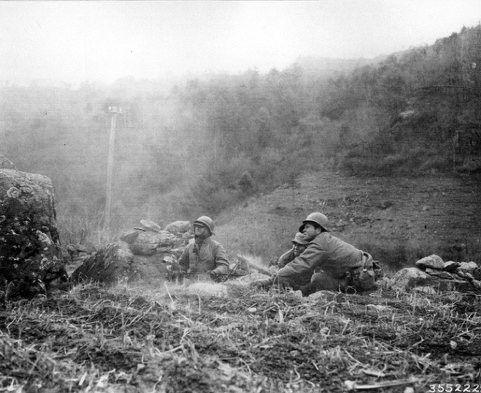
Co. C, 65th Infantry Regt. 3rd Infantry Div., fires light machine guns on Chinese communist troops in the hills near Maejong, North Korea; November, 27 1950. US Army Photo 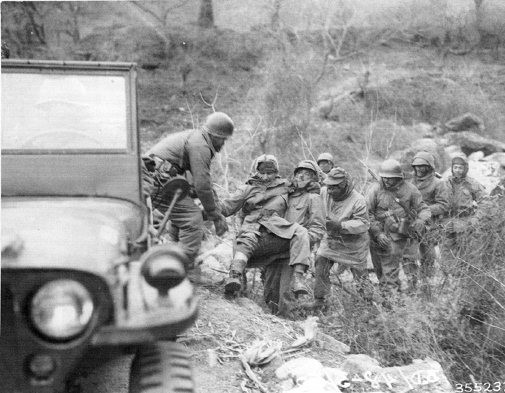
Sfc. Robert Forsythe, Signal Corps Photographer who took above photo, is evacuated after being wounded while on an official photo mission with Co. C, 65th Inf. Regt. near Maejong, North Korea; December 9, 1950. US Army Photo |
One of the Regiment’s most important missions was to assist with the US Marine evacuation from the Chosin Reservoir. After 17 days of brutal fighting across the frozen mountain terrain of North Korea, UN troops had finally reached Hungnam with the 65th Infantry Regiment holding the rear. The Borinqueneers set up defenses around Hungnam, while troops, civilians, supplies, and equipment were evacuated by ship. A total of 105,000 troops, 98,000 civilians, 17,500 vehicles, and 350,000 tons of supplies were evacuated from Hungnam to Pusan.
The Borinqueneers were among the last UN troops to leave Hungnam when the evacuation was completed on the afternoon of December 24.
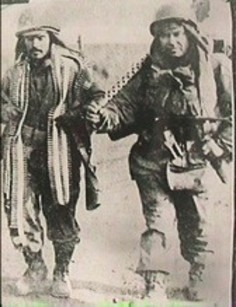
On Christmas Eve 1950, Corporal Julio Guzman (San Juan) and Sgt Major Lupercio Ortiz (Barranquitas) were the last two US soldiers to evacuate the beachhead at Hungnam. Earlier when the US Marines were encircled by the Chinese Communist troops close to the Manchurian border, the Marines were ordered to retreat and work their way back to Hungnam. The 65th Inf. Regiment Borinqueneers rushed to their defense and stayed behind to fight the enemy. |
Chinese troops entered Hungnam the following day to discover that the port had been destroyed by retreating UN troops, making the port useless to the Chinese and North Koreans. China’s dramatic victory was muted by the successful UN withdrawal from the Chosin Reservoir and Hungnam. The US X Corps was able to preserve its fighting strength despite heavy losses. Commanders of the X Corps and 3rd Infantry Division praised the 65th Infantry Regiment for its outstanding performance. The regiment had suffered 120 casualties but inflicted massive losses upon enemy forces attempting to encircle them. Eleven Silver Stars were awarded to men in the Regiment for extraordinary gallantry, including Colonel William W. Harris. The regiment was also awarded a Navy Unit Commendation for actions with US marines in the battle.
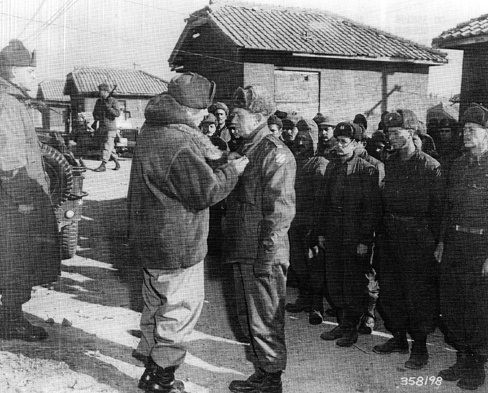
Maj. General Edward M. Almond awarding the Silver Star to Col. William W. Harris, commanding officer of the 65th Infantry in Hungnam, North Korea after the eegiment’s incredible fight from the Chosin Reservoir; December 22, 1950. US Army Photo. 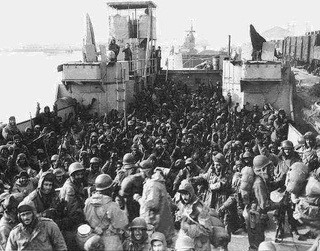
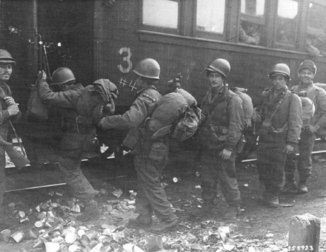
Men of the 65th Infantry Regiment board a train in Pusan upon arrival from Hungnam by ship. They were among the last to evacuate from Hungnam. US Army Photo |
The massive Chinese offensive had forced the UN Coalition to retreat across the 38th Parallel. The Chinese army advanced south capturing Seoul on January 7, 1951. But by this point, the Chinese army was completely exhausted, and the UN Coalition would soon launch a counter-offensive.
On January 31, the 65th Infantry launched an attack on three strategic hills just south of Seoul. After three days of fighting, the Borinqueneers charged forward with fixed bayonets onto the final enemy positions, forcing the Chinese to retreat. Commanding General Douglas MacArthur later wrote of the regiment’s performance stating, “The Puerto Ricans forming the ranks of the gallant 65th Infantry Regiment on the battlefields of Korea by valor, determination and a resolute will to victory give daily testament to their invincible loyalty to the United States and the fervor of their devotion to those immutable standards of human relations to which the Americans and the Puerto Ricans are in common dedicated. They are writing a brilliant record of achievement in battle and I am proud indeed to have them in this command. I wish that we might have many more like them.”[2]
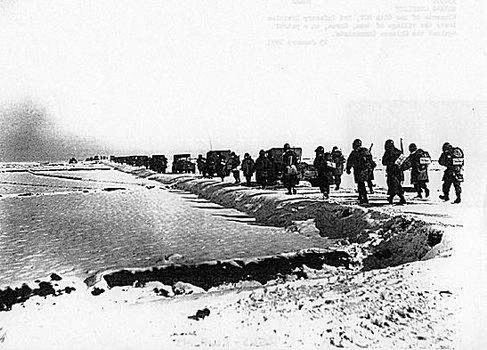
Elements of the 65th Infantry Regiment leave Osan, South Korea, on a patrol against the Chinese forces; January 15, 1951. US Army Photo |
In February, 1951, the 65th Infantry took part in Operation Killer. It was the first unit to cross the Han River and was one of the first units to reenter Seoul. In March, the 65th Infantry managed to destroy an entire North Korean regiment that had attempted to attack the 3rd Infantry Division from the rear. In April, the 65th Infantry led the 3rd Infantry Division in an offensive that defeated elements of the Chinese 26th Army.
During the Chinese Spring Offensive, the 65th Infantry fought off two Chinese divisions. The Borinqueneers retreated in good order and counter-attacked whenever possible. From May to July, the 65th Infantry was instrumental in the defense of the Chorwon Valley and defeating communist forces in the Iron Triangle. By the end of 1951, the 65th Infantry had suffered 1,510 casualties, but was credited with 15,787 enemies killed in action and capturing 2,169 prisoners.

65th Infantry Regiment moving under enemy fire; June 1, 1951. US Army Photo. |
By the start of 1952, the UN Coalition and the communist forces were holding positions along the 38th Parallel. Both sides realized the futility of trying to drive each other off the Korean Peninsula. Instead, the war would end through negotiations. For troops on the 38th parallel, the fighting would be a grueling war of attrition to wear down the opposing side. Instead of massive offensives across the Peninsula, each side would be fighting for insignificant hills, ridges, and mountains, anything which could be used as a bargaining chip in negotiations. The 65th Infantry found itself defending the Chorwon Valley, launching only occasional raids against Chinese positions.
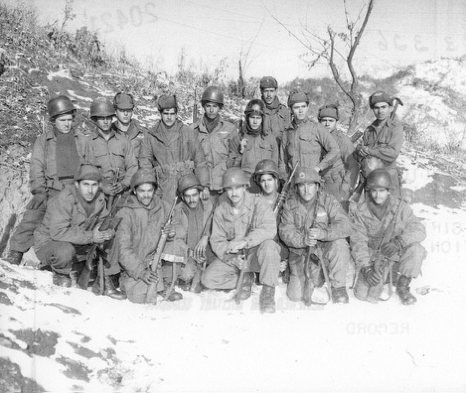
“Raiders” 3rd Battalion, 65th Infantry; January, 1952. |
On February 1, 1952, the regiment came under the command of Colonel Juan Cesar Cordero-Davila. Colonel Cordero-Davila was a World War II veteran who served with the 65th Infantry. He commanded the Puerto Rican National Guard, was responsible for training most of the men in the regiment, and was the highest ranked ethnic officer in the army. This came at a time when the US Army was ending segregation. It signaled a changing attitude within the army over the role of minorities.
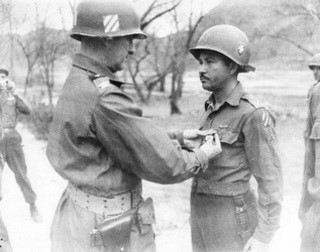
Cpl. Enrique Vega-Lugo receives the Silver Star from Col. Juan Cesar Cordero at Regiment HQ; April 16, 1952. US Army Photo 
C Company, 2nd Platoon, 65th Infantry Regiment; 1952 |
During the fall of 1952, the Chinese army had completed a major build-up in preparation for massive offensives meant to gain better strategic positions before the winter season, and to gain an advantage in the ongoing peace talks. The Borinqueneers would bear the brunt of heavy fighting.
In September, the 65th Infantry was defending a position called Outpost Kelly near Yonchon, North Korea. Throughout September, the Borinqueneers fought elements of the Chinese 39th army for control of the Outpost. The fighting was fierce and bloody, but despite the Borinqueneers’ valiant efforts, Outpost Kelly ultimately ended up in enemy hands. The 65th Infantry suffered a total of 542 casualties, making it the regiment’s deadliest engagement of the war.
After a review of his conduct during the Battle of Outpost Kelly, Colonel Cordero-Davila was relieved of command for “poor judgment, poor leadership, and poor decision making.” The regiment was then placed under the command of Colonel Chester B. DeGavre.
In October, the Chinese launched another series of offensives. The 65th Infantry would once again be called to defend an area called Jackson Heights on the eastern edge of the Chorwon Valley. The battle pushed the regiment to its breaking point. G Company fought desperately to hold onto an outpost on Hill 391 but was forced to withdraw in fear of being overrun by a larger Chinese force. During the battle, elements of L Company refused to attack when ordered.
Under Colonel DeGavre, morale within the regiment had deteriorated. After the loss of Outpost Kelly, Colonel DeGavre ordered all the men to shave their mustaches “until such time as they give proof of their manhood,” and made some of them wear signs saying, “I am a coward.”[3] Many of the Borinqueneers considered DeGavre’s order an insult.
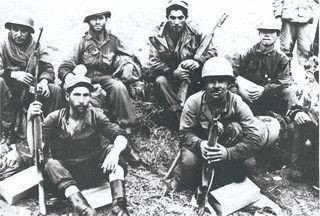
|
The 65th Infantry’s performance issues in the fall of 1952 could be attributed to a number of causes: a shortage of qualified non-commissioned officers (NCO’s), a rotation schedule that removed the most combat-experienced men, a high casualty rate, a shortage in ammunition, a language barrier between enlisted men and American officers, since many of the replacements couldn’t speak English, and poor leadership of the regiment’s commanding officers leading to a breakdown in morale.
In December, 1954, 162 soldiers of the 65th Infantry were arrested for acts of insubordination and mutiny that occurred during the Battle of Jackson Heights. Ninety-one soldiers were ultimately found guilty and sentenced to terms ranging from one to 18 years of hard labor. It was the largest mass court-martial of the Korean War. The media soon brought the incident to public attention, leading to negotiations between the Puerto Rican and US governments, which ultimately led to pardons for all the soldiers involved.
From 1952 to 1953, the frontlines in Korea shifted back and forth around the 38th Parallel. The 65th Infantry would continue to fight with great determination and skill against a desperate enemy. Replacements and an influx of continental Americans into the regiment slowly erased the Puerto Rican identity of the 65th Infantry. Finally, by the summer of 1953, the UN Coalition and the communist forces had exhausted themselves in bitter fighting. An Armistice was signed between the two sides, which ended the fighting on July 27, 1953.
Recognition
During those three years of war in Korea, one out of every 42 US military casualties was Puerto Rican. 61,000 Puerto Ricans served in the US military during the Korean War, of which 48,000 served in the 65th Infantry; 743 Borinqueneers were killed in action, and 2,318 were wounded. The 65th Infantry was one of the most decorated units of the Korean War, participating in nine campaigns. The regiment earned a total of ten Distinguished Service Crosses, 256 Silver Stars, 606 Bronze Stars, and 2,771 Purple Hearts. The regiment was credited with the last battalion-sized bayonet charge by a US Army unit. By November, 1954, the 65th Infantry was relieved of assignment and sent back to Puerto Rico.
“El Monumento de la Recordacion” (Monument of Remembrance) was erected in front of the Capitol Building in San Juan, Puerto Rico in 1996. Inscribed on the Monument of Remembrance are the names of over 1,200 Puerto Ricans who have died in service to the United States. Many of those served in the 65th Infantry. In San Juan, one of the city’s main avenues, “La 65 de Infanteria,” is named in honor of the Regiment. On November 30, 2012, a portion of Southern Boulevard in Bronx, New York was renamed in honor of the 65th Infantry, “La 65 de Infanteria Boulevard.”
As of 2012, there has been a movement to persuade the US Congress to reward the 65th Infantry with the Congressional Gold Medal. Notable units that have been awarded the Congressional Gold Medal include the Navajo Code Talkers, the Tuskegee Airmen, the Nisei Soldiers, and the Montford Point Marines.
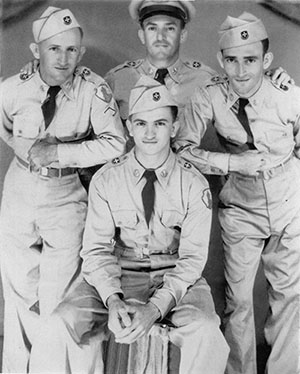
The Reyes-Castaneira brothers all served in the 65th Infantry Regiment. The youngest (front center) is a member of the alliance to petition Congress for the Congressional Gold Medal for the Borinqueneers. His older brothers are now deceased. |
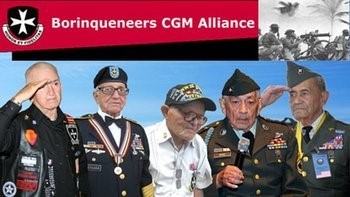
Borinqueneers Congressional Gold Medal Alliance 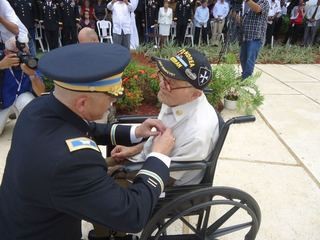
Don Luis Ramos of Cayey received his Bronze Star and other medals in 2012, sixty years after serving as a Borinqueneer in Korea. |
Today the 65th Infantry is still an active duty regiment in the US Army based in Puerto Rico. The regiment has successfully completed multiple tours in Iraq and Afghanistan. The 65th Infantry “unofficially” still carries the nickname “Borinqueneers.” Since its founding, the Puerto Ricans of the 65th Infantry have held up to their motto, Honor et Fidelitas (Honor and Fidelity). Former Puerto Rican Governor Luis Munoz Marin spoke with great pride about the Borinqueneers stating; “The flag of the United States, which they followed with devotion into battle, represents their great democratic faith as citizens of the United States. The flag of the Commonwealth of Puerto Rico, under which they proudly fought, represents in their hearts those ideals important to Puerto Rico, for their homes in the villages and hills of Puerto Rico, their pride in their traditions, and their hope that their island would assume each day a greater role as an exporter and understanding between the peoples of all countries.”
“No ethnic group has greater pride in itself and its heritage than the Puerto Rican people. Nor have I encountered any that can be more dedicated and zealous in support of the democratic principles for which the United States stands. Many Puerto Ricans have fought to the death to uphold them.” General William W. Harris, former Commanding Officer of the 65th Infantry Regiment
| * * * |
Show Notes
| * * * |
© 2026 Daniel Ramos
Written by Daniel Ramos. If you have questions or comments on this article, please contact Daniel Ramos at: danielramos16@msn.com.
About the author:
Daniel Ramos is a military history buff with a special interest in WWII, the Korean and Vietnam Wars, and the wars in Afghanistan and Iraq. He has been a Tour Guide at the Intrepid Museum in NYC and is currently working on a historical fiction novel set during WWII. You can find his military blog here: http://militarywiz.tumblr.com/.
* Views expressed by contributors are their own and do not necessarily represent those of MilitaryHistoryOnline.com.

